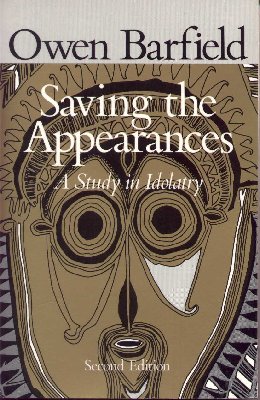The text on this page is from David Lavery, "An Owen Barfield Readers Guide." Seven 15 (1998): 97-112.
|
Saving the
Appearances: |
Saving the Appearances: A Study in Idolatry. London: Faber and Faber, 1957; reissued New York: Harcourt, Brace and World, 1965; Middletown, CT: Wesleyan U P, 1988.
The idols are tough and hard to crack, but through the first real fissure we make in them we find ourselves looking, how deeply, into a new world! If the eighteenth-century botanist, looking for the first time through the old idols of Linnaeus's fixed and time- less classification into the new perspective of biological evolution felt a sense of liberation and of light, it can have been but a candle-flame compared with the first glimpse we now get of the familiar world and human history lying together, bathed in the light of the evolution of consciousness. (Saving the Appearances 72)
Barfield’s most important book (his own opinion and by general consensus as well) was the product of a new amount of free time for his intellectual pursuits made possible by diminishing involvement in the law. Saving the Appearances, a book made up of a variety of short but densely packed chapters resulting in a "a sort of outline sketch, with one or two parts completed in greater detail, for a history of human consciousness, particularly the consciousness of western humanity during the last three thousand years or so" (Saving 13), crystallized out of wide reading in anthropology, history of science, and philosophy. It is Since Barfield never authored the magnum opus he once imagined in a poem, Saving the Appearances will have to play that role. It comes closer than any of his other works to laying out methodically, in less than two hundred pages, Barfield’s "system." In writing about Worlds Apart, his next published book, R. J. Reilly has taken note of "the progression" Barfield system intends: an evolution "from the solitude of private thought, to the strengthened thought that rays out into the thought of the universe, to the absolute dissolution of private thought in the universe, or the Kingdom--or from subjective idealism to Anthroposophy to heaven" (76). Saving the Appearances is the Baedeker for such a journey.
|
Table of Contents Introduction 11-14I The Rainbow 15-18 II Collective Representations 19-21 III Figuration and Thinking 22-27 IV Participation 28-35 V Pre-History 36-39 VI Original Participation 40-45 VII Appearance and Hypothesis 46-52 VIII Technology and Truth 53-57 IX An Evolution of Idols 58-64 X The Evolution of Phenomena 65-70 XI Medieval Environment 71-78 XII Some Changes 79-83 XIII The Texture of Medieval Thought 84-91 XIV Before and After the Scientific Revolution 92-95 XV The Graeco-Roman Age (Mind and Motion) 96-106 XVI Israel 107-115 XVII The Development of Meaning 116-121 XVIII The Origin of Language 122-125 XIX Symptoms of Iconoclasm 126-132 XX Final Participation 133-141 XXI Saving the Appearances 142-147 XXII Space Time and Wisdom 148-155 XXIII Religion 156-166 XXIV The Incarnation of the Word 167-173 XXV The Mystery of the Kingdom 174-186 |
